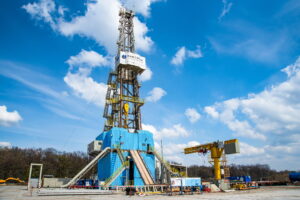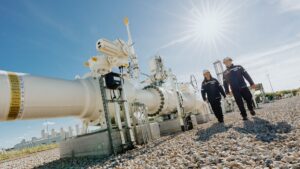
PJSC Ukrnafta is working on implementing projects to generate energy from its own gas with a total capacity of up to 370 MW.
According to the company’s press release, this was announced by Duncan Nightingale, Chairman of the Supervisory Board of Ukrnafta, during the World Economic Forum in Davos.
He thanked the governments of Sweden, Norway, the Netherlands and the United States, as well as the European Bank for Reconstruction and Development (EBRD) for their support on the path to sustainable development and invited new partners to join the implementation of ambitious promising projects.
“We need to invest in Ukraine now. If you wait for the war to end, you may lose the most profitable projects,” Nightingale emphasized.
For his part, EBRD Vice President Matteo Patrone noted the positive financial results achieved by the company and improvements in the management system.
“They (Ukrnafta – IF-U) have demonstrated not only excellent financial results, but also true corporate governance. This is the achievement of Sergiy (Koretsky) and the Board. If two years ago I had been asked whether we would support Ukrnafta, I would have said no. But what has happened over the past 18 months is simply amazing,” he said.
“Ukrnafta is Ukraine’s largest oil producer and operator of a national network of filling stations. In March 2024, the company took over the management of Glusco’s assets and operates 547 filling stations – 462 owned and 85 managed.
The company is implementing a comprehensive program to restore operations and update the format of its filling stations. Since February 2023, the company has been issuing its own fuel coupons and NAFTAKarta cards, which are sold to legal entities and individuals through Ukrnafta-Postach LLC.
“Ukrnafta holds 92 special permits for commercial development of fields. It has 1832 oil and 154 gas production wells on its balance sheet.
Ukrnafta’s largest shareholder is Naftogaz of Ukraine with a 50%+1 share.
In November 2022, the Supreme Commander-in-Chief of the Armed Forces of Ukraine decided to transfer to the state a share of corporate rights of the company owned by private owners, which is currently managed by the Ministry of Defense.

Ukrnafta PJSC produced 1.170 billion cubic meters of gas in 2024, which is 6.5% more than in 2023 (1.097 billion cubic meters) and 1.418 million tons of oil, which is 0.6% more than in the previous year (1.410 million tons). According to the company’s press release on Thursday, production growth in oil equivalent in 2024 amounted to an additional 70.5 thousand tons of hydrocarbons, or 3%: 2.42 million tons against 2.35 million tons in 2023.
“Despite prolonged power outages that limited mechanized oil production, the company managed not only to compensate for the natural decline but also to ensure an increase in oil and gas volumes,” said Sergiy Koretsky, Ukrnafta’s CEO, as quoted in the press release. He added that the company has been improving its production figures for the second year in a row.
According to the company, in 2025, Ukrnafta will continue to drill new wells, upgrade equipment, replacing Soviet equipment with modern and technological equipment from world leaders, and intensify production.
“Ukrnafta is Ukraine’s largest oil producer and operator of the national network of gas stations. In March 2024, the company took over the management of Glusco assets and operates 547 filling stations – 462 owned and 85 managed.
The company is implementing a comprehensive program to restore operations and update the format of its filling stations. Since February 2023, the company has been issuing its own fuel coupons and NAFTAKarta cards, which are sold to legal entities and individuals through Ukrnafta-Postach LLC.
“Ukrnafta holds 92 special permits for commercial development of fields. It has 1832 oil and 154 gas production wells on its balance sheet.
Ukrnafta’s largest shareholder is Naftogaz of Ukraine with a 50%+1 share.
In November 2022, the Supreme Commander-in-Chief of the Armed Forces of Ukraine decided to transfer to the state a share of corporate rights of the company owned by private owners, which is currently managed by the Ministry of Defense.

In 2024, the OKKO filling station network put into operation 23 modules for refueling cars with liquefied petroleum gas (LPG), bringing the total number to 356, the company’s press service reports.
In particular, five of them were launched as part of new filling stations, and another 18 were installed on the territory of existing complexes. Last year, the company invested UAH 80 million (excluding VAT) in expanding its gas filling service.
“As a result, drivers can choose this type of fuel at 85% of the network’s filling stations in all regions of Ukraine,” the press service said.
The largest number of autogas filling stations is in Lviv region – 56, Kyiv region – 32, Kyiv – 30, Dnipropetrovs’k region – 27, Vinnytsia – 26, Ivano-Frankivsk – 24.
The company’s plans for 2025 include the installation of about 10 more LPG modules.
As reported, according to the Group’s CEO Vasyl Danyliak, OKKO occupies about 19% of the Ukrainian retail fuel market in the fall of 2024.
OKKO Group unites more than 10 diversified businesses in production, trade, construction, insurance, maintenance and other services. The flagship company of the group is Galnaftogaz, which operates one of the largest filling stations in Ukraine under the OKKO brand, with 410 filling stations.
Vitaly Antonov’s GNG Retail Limited owns 90.25% of Concern Galnaftogaz shares. In October 2024, Avalia Investments Limited (Cyprus) became the owner of another 7.35% of the shares.

US President Donald Trump has lifted the moratorium on the issuance of new liquefied natural gas (LNG) export licenses imposed by his predecessor Joe Biden. The US Department of Energy reported that it is returning to the normal regime of reviewing export applications in accordance with Trump’s order.
“The Department has been instructed to resume reviewing applications for the export of US LNG to countries that do not have a free trade agreement with the United States. The proper review of export applications is required by law and must be carried out accordingly,” the Energy Ministry said in a statement.
In December, the agency published the results of a study on LNG exports and set February 18 as the deadline for public comments on it. Now the Ministry of Energy has decided to extend the comment period until March 20, 2025.
Earlier, the Experts Club think tank, Brian Mefford and Maxim Urakin, released a video analysis on what changes are expected to occur in US domestic and foreign policy under Trump, the video is available on the Experts Club YouTube channel – https://youtu.be/W2elNY1xczM?si=MM-QjSqGce4Tlq6T
EXPERTS CLUB, EXPORT, GAS, LICENSE, MORATORIUM, TRUMP, URAKIN, Меффорд

In 2024, Ukrgasvydobuvannya JSC increased commercial gas production by 5.3% (by 0.7 bcm) compared to 2023 – up to 13.9 bcm, the press service of Naftogaz Group reports.
According to it, last year the company commissioned 83 new wells, of which 60 were production wells and 23 were exploration wells.
“UGV also increased the number of directional wells drilled from 51 to 60 over the year, which allows for gas production in hard-to-reach areas. In addition, the company drilled 370 thousand meters over the year, which is 14% more than in 2023.
“Naftogaz Group not only maintains stability, but also demonstrates an increase in gas production. Every day our people demonstrate the ability to adapt to current challenges and ensure development even in the most difficult conditions. I am grateful to my colleagues for their teamwork and sincere dedication to the profession,” said Roman Chumak, Acting Chairman of Naftogaz of Ukraine. Roman Chumak.
As reported, Ukrgasvydobuvannya produced 13.224 billion cubic meters of commercial gas in 2023, which is 0.679 billion cubic meters more than in 2022.
NJSC Naftogaz of Ukraine owns 100% of Ukrgasvydobuvannya shares.

Vladimir Putin might have lost a slice of revenue after Kyiv closed its gas pipeline to Russian supplies, but Moscow already has alternatives for shipping the fuel that stand to shield it from any serious economic hit.
Russia plans to expand exports of liquefied natural gas while routing pipeline gas to other buyers like China.
“We will continue to increase our share on world LNG markets” even as sanctions aim to halt this growth, Putin said during his annual press conference on Dec 19. He also expressed confidence that Russian gas-giant Gazprom PJSC would survive the end of pipeline transport through Ukraine.
Despite calls to ban such supplies, Europe is buying a record amount of the super-chilled fuel from Russia, predominantly from the Novatek PJSC-led Yamal LNG plant.
The volumes have surpassed what Russia was selling through Ukraine before Jan. 1, when Kyiv, refusing to allow any more transit that funds Moscow’s war machine, closed off the five-decade old route through its territory.
The situation highlights how hard it is for Europe to cut ties with Russia, which over the last decade entrenched itself as a key commodities supplier to the continent. It also casts a spotlight on how the February 2022 invasion of Ukraine has forced Russia to keep readjusting its trading network. Still, Moscow has shown that even when one avenue to markets closes, there are often others still open for Russia.
Russia’s LNG exports overall reached a record last year, ship-tracking data show.
Before the invasion, Russia used to sell about 155 billion cubic meters of pipeline gas to Europe per year. In 2024, the country exported roughly 30 billion cubic meters of gas to the region, with over a half of volumes going via Ukraine.
Since most of Russia’s piped gas had already stopped flowing to Europe, the discontinuation of the Ukrainian line won’t affect the economy much, said Tatiana Orlova, an economist at Oxford Economics.
“Europe will still need gas as all its efforts to wean itself from Russian gas have not been successful,” Orlova said. “It will probably end up buying more Russian LNG to make up for the drop in natural gas imports from Russia,” she said.
Gazprom sold about $6 billion worth of gas through Ukraine in 2024, Bloomberg calculations show. Yet, most economists and researchers foresee a muted effect on the economy from being deprived of those sales. Russia will lose an equivalent of about 0.2% to 0.3% of gross domestic product, according to various analyst estimates.
“The figures are too small to make a dent in Putin’s war machine,” David Oxley, an economist at Capital Economics said in a note last week. For comparison, Ukraine stands to lose roughly 0.5% of GDP, he said, stemming from an end to the fees it collected for transit of the gas.
Slovakia, heavily reliant on Russian gas and also earning from transit fees, is set to lose 0.3% of GDP, according to his estimates.
On top of LNG sales, Russia also has other pipeline options for shipping gas that will help make up for the loss of the route through Ukraine.
Shipments to China, which is overtaking Europe as the largest market for Russia’s pipeline gas, were forecast to reach around a record 31 billion cubic meters in 2024. They are set to rise to 38 billion cubic meters this year as the Power of Siberia link has reached the full design capacity.
That would compensate for half of the volumes lost when transit via Ukraine ended, according to estimates by Sergey Vakulenko, a scholar at the Carnegie Endowment for International Peace.
Gazprom may sell more through TurkStream, the direct gas pipeline between Russia and Turkey under the Black Sea that also helps supply some European clients. In 2025, Gazprom could sell 25 billion cubic meters to Turkey and 15 billion cubic meters to Europe through TurkStream, Vakulenko estimates.
Russia plans to re-direct some fuel to countries in Central Asia and will work to increase the capacity of a Soviet-era pipeline from Russia to Uzbekistan through Kazakhstan.
Politically, the gas issue gives the Kremlin an opportunity to demonstrate that Putin isn’t a pariah, said Sergei Markov, a political consultant close to the Kremlin.
“For Moscow, it is extremely important that the diplomatic blockade is being broken for the second time,” Markov said, referring to Slovak Prime Minister Robert Fico’s surprise visit to Moscow on Dec. 23 to discuss gas among other things. He was the second European leader to visit Moscow since Russia invaded Ukraine after Hungarian Prime Minister Viktor Orban’s trip in July.
Putin last month said that Russia is ready to ship gas to Europe, but he cautioned that any new deal would likely be complicated to reach, even given the rising prices from tighter supply now facing Europe.
Still, the plans for both pipeline gas and LNG may face challenges of their own. While Russia aims to launch exports via a second link to China in two years, talks for a third pipeline have stalled over disagreements about the terms.
Russia seeks to triple LNG exports to 100 million tons in 2035, from last year’s 33 million tons, but western sanctions on all key future projects and the LNG tanker fleet complicate that.
“The natural gas and LNG landscape has changed dramatically for Russia in the last three years,” said Claudio Steuer, an energy consultant and faculty member of IHRDC, Boston. It requires “far greater investment and effort for a less profitable business” now that Russia needs to search for business further afield with buyers that are more price sensitive.
Sanctions have already stifled Russia’s aims for growth in LNG. Novatek’s newest project, Arctic LNG 2, last year managed to start limited exports, but sanctions imposed by the US and its allies limited the plant’s access to ice-class tankers needed to navigate frigid northern waters and made foreign buyers reluctant to buy the shipments.
In 2025, the focus will be on what Donald Trump decides to do about sanctions on Russia. Muddying the picture are the US’s own ambitions to supply more of its LNG to Europe.
A ban on transshipping Yamal LNG cargoes in European ports could also complicate logistics for Russian supplies to Asia when the Northern Sea Route is closed, but sanctions may actually lead to more of that supply being sent to Europe instead.